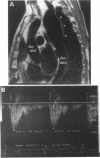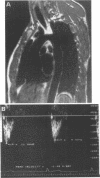Abstract
OBJECTIVE--To compare the usefulness of magnetic resonance imaging (MRI) and Doppler ultrasound with that of cross sectional echocardiography and oscillometric blood pressure measurement for the evaluation of aortic coarctation after surgical repair. DESIGN--Prospective study. Aortic diameters measured by cross sectional echocardiography, MRI, and angiography (selected cases) and functional data determined by physical examination, oscillometric blood pressure measurement, and continuous wave Doppler. SETTING--Tertiary referral centre. PATIENTS--40 patients aged 2-28 years (mean 10.6 years) who had had surgical correction of aortic coarctation (mean follow up 5.7 years). RESULTS--In all patients MRI gave diameter measurements of the aortic arch and the thoracic aorta whereas in half of them cross sectional echocardiographic measurement of the isthmic region failed. The correlation coefficient for aortic diameters measured by MRI and angiography was 0.97 and that between MRI and echocardiography was 0.89. Peak velocities in the descending aorta correlated better with residual narrowing of the aortic isthmus or distal aortic arch or both than systolic blood pressure gradients between the upper and lower limbs. A peak velocity of < 2 m/s in the descending aorta during systole excluded important restenosis. Prolongation of anterograde blood flow during diastole always indicated a morphological abnormality--either important restenosis or aneurysmal dilatation. CONCLUSIONS--MRI was better than cross sectional echocardiography for imaging the aortic arch after coarctation repair and measuring its diameter. Peak velocity in the descending aorta correlated better with residual stenosis than did the systolic blood pressure gradient between the upper and lower limbs and this index could be used to indicate a need for MRI.
Full text
PDF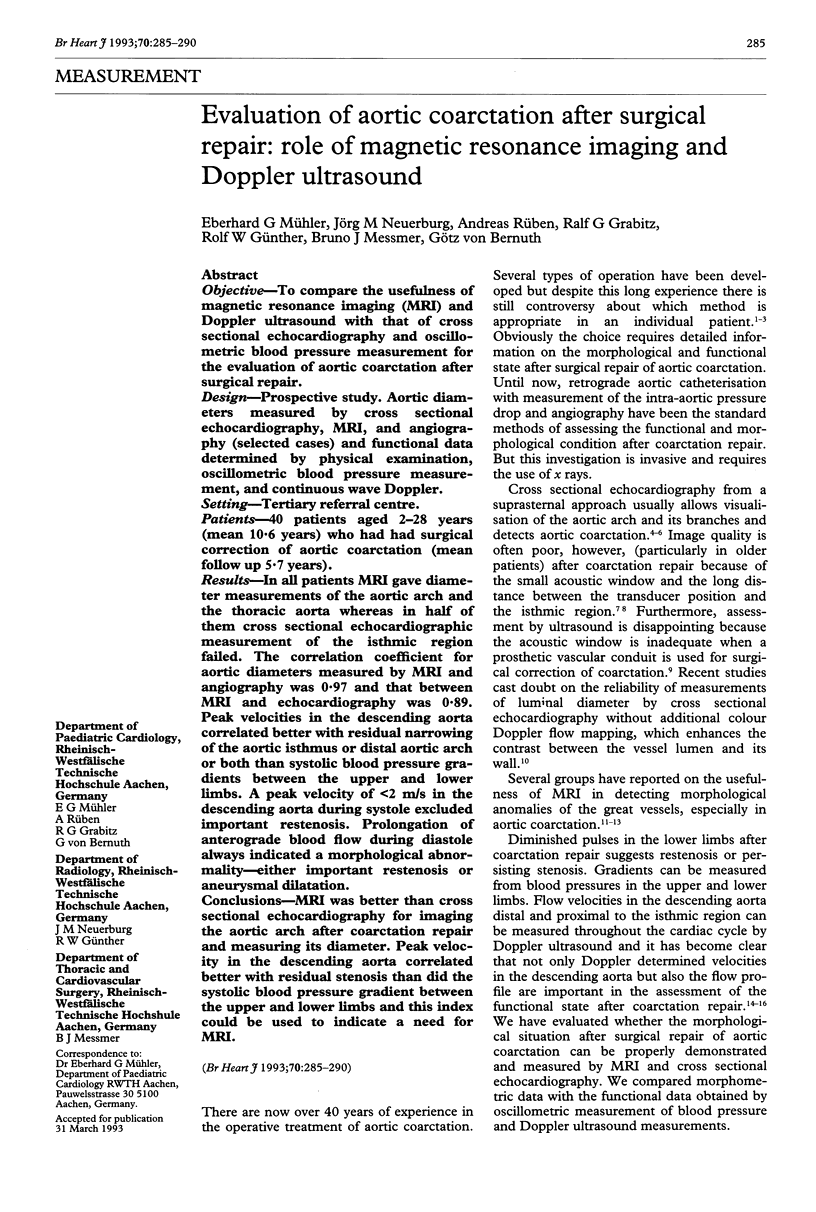
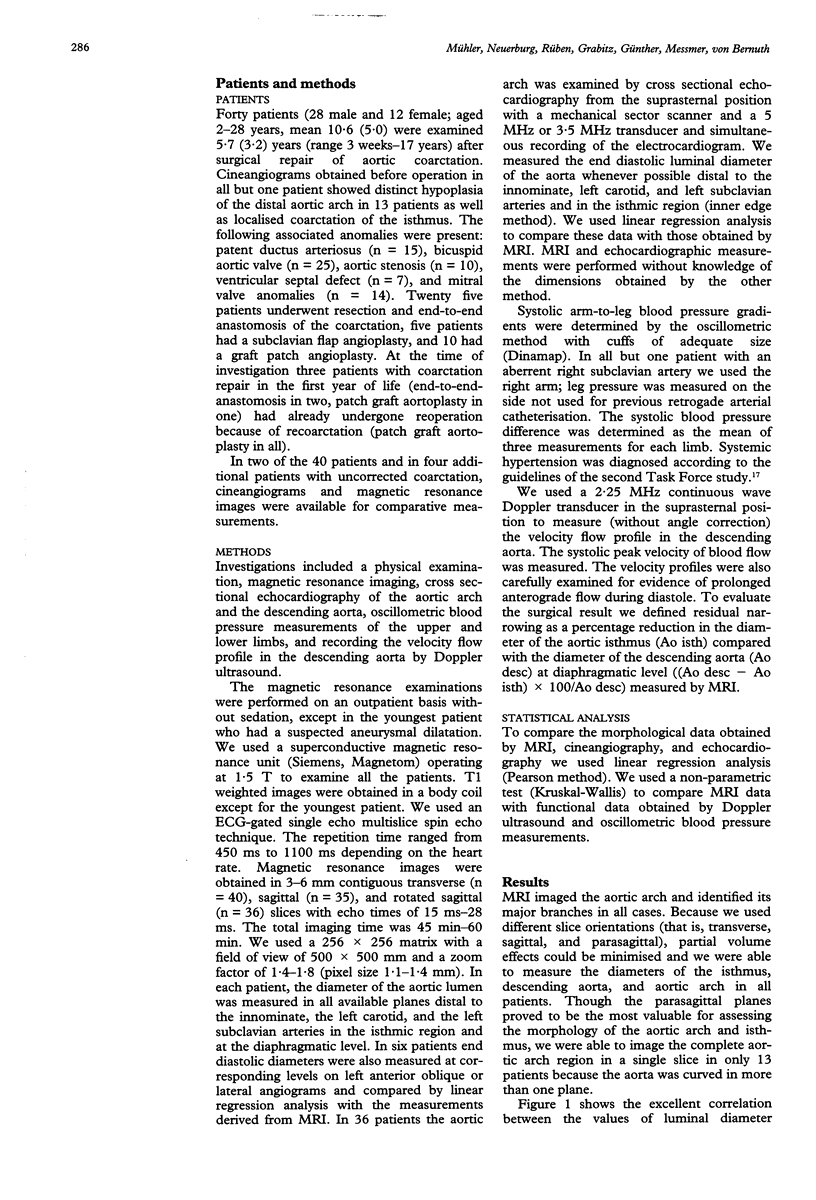
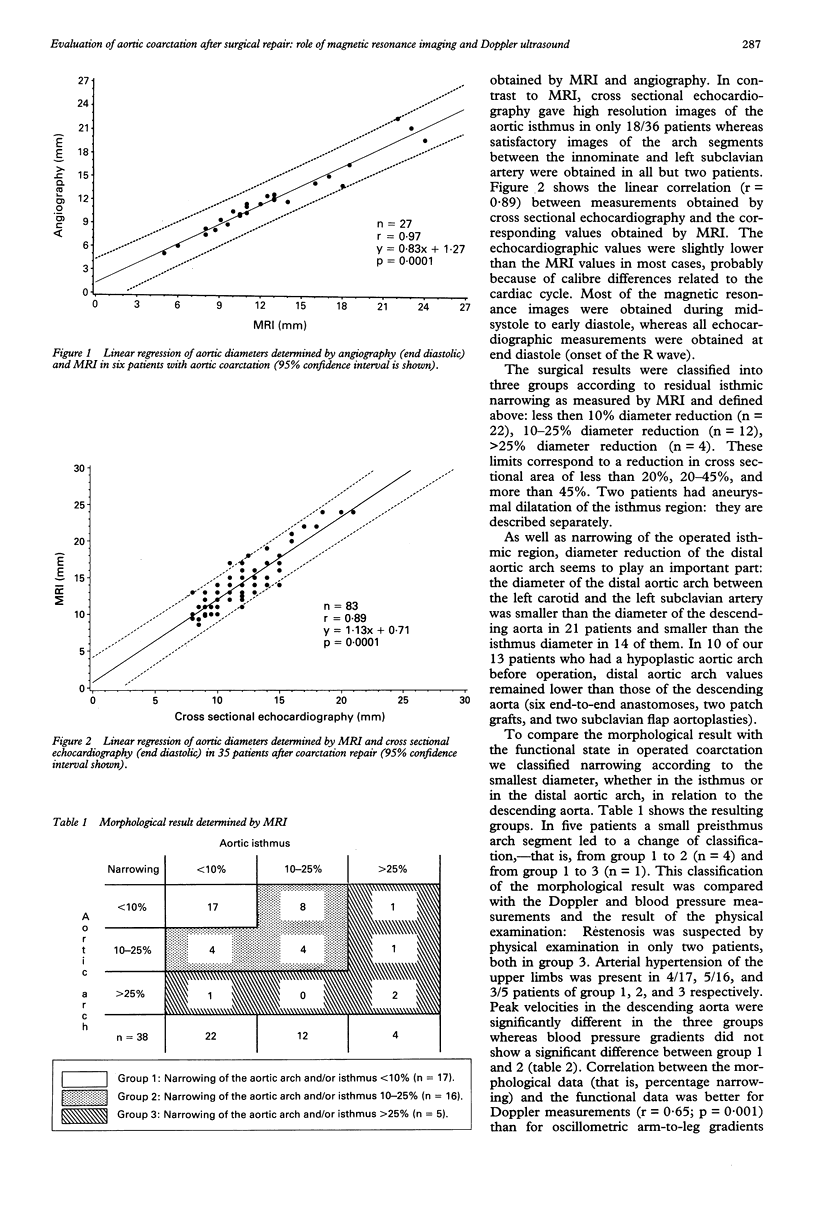
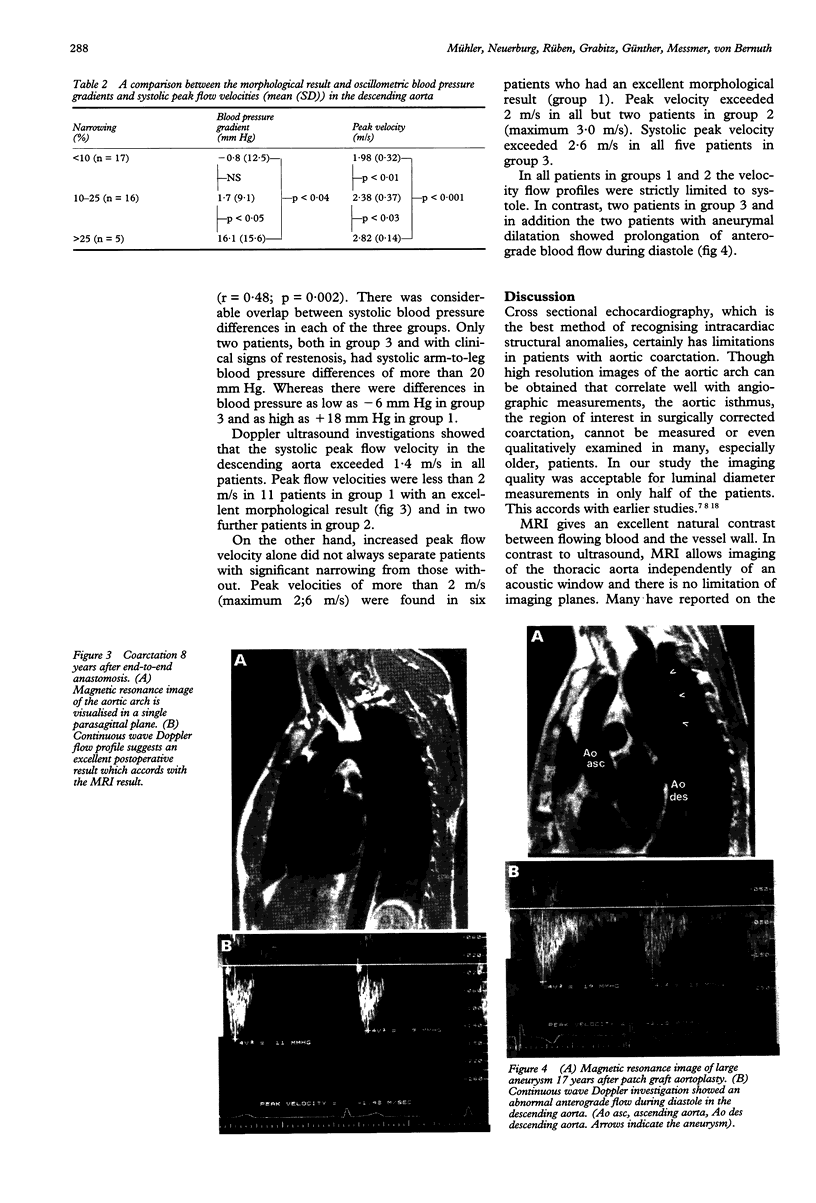
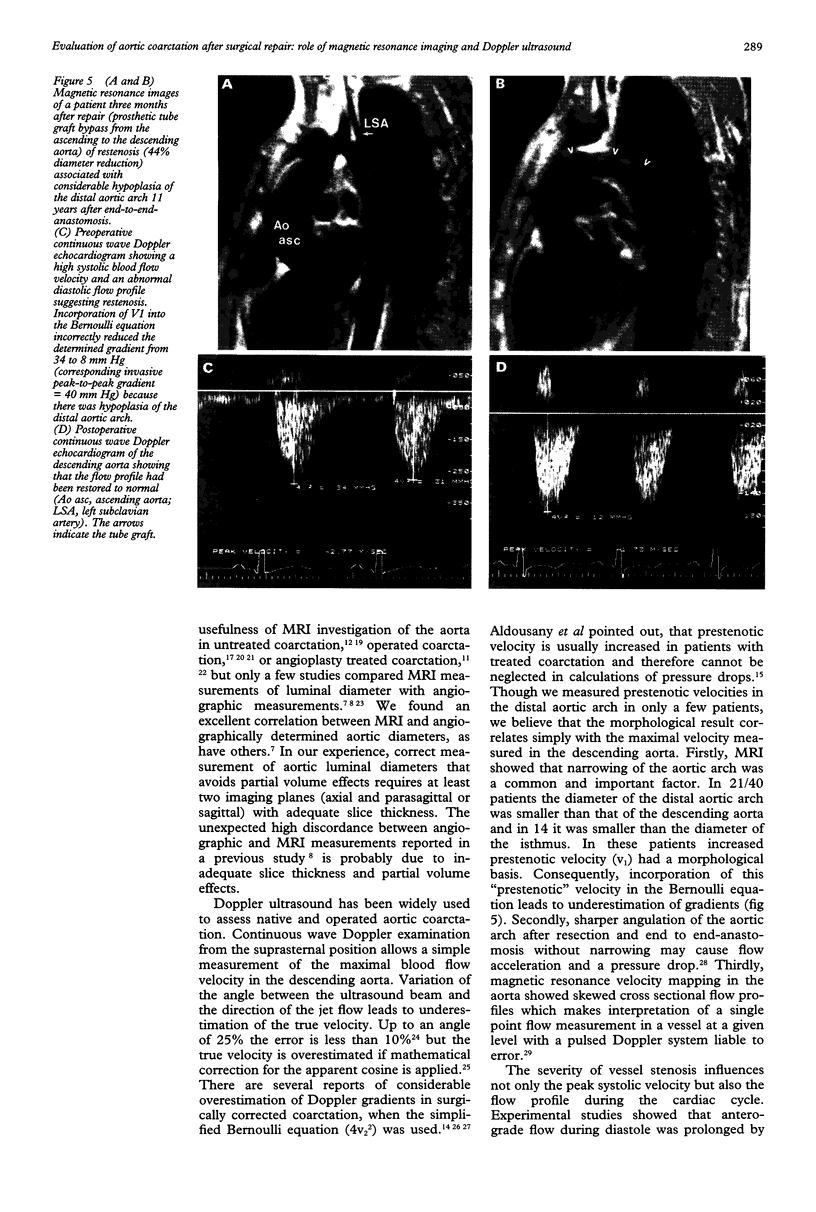
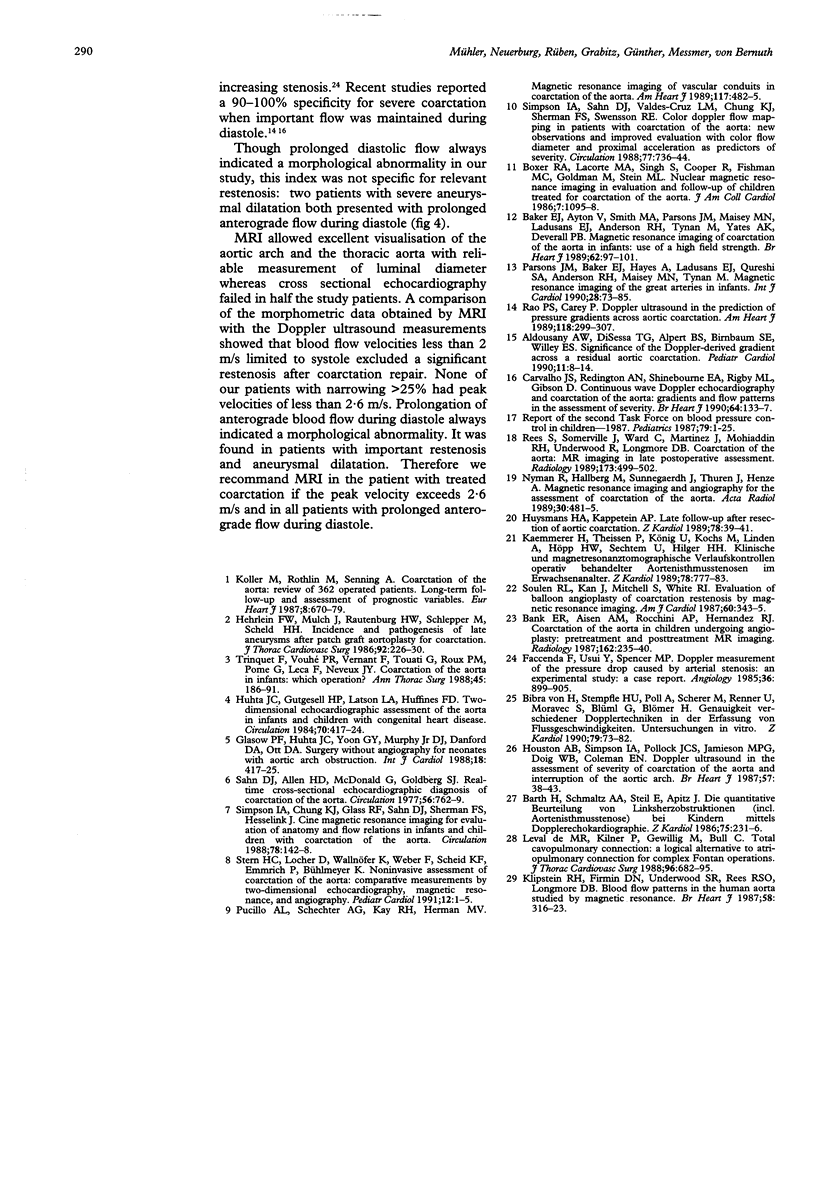
Images in this article
Selected References
These references are in PubMed. This may not be the complete list of references from this article.
- Aldousany A. W., DiSessa T. G., Alpert B. S., Birnbaum S. E., Willey E. S. Significance of the Doppler-derived gradient across a residual aortic coarctation. Pediatr Cardiol. 1990 Jan;11(1):8–14. doi: 10.1007/BF02239541. [DOI] [PubMed] [Google Scholar]
- Baker E. J., Ayton V., Smith M. A., Parsons J. M., Maisey M. N., Ladusans E. J., Anderson R. H., Tynan M., Yates A. K., Deverall P. B. Magnetic resonance imaging of coarctation of the aorta in infants: use of a high field strength. Br Heart J. 1989 Aug;62(2):97–101. doi: 10.1136/hrt.62.2.97. [DOI] [PMC free article] [PubMed] [Google Scholar]
- Bank E. R., Aisen A. M., Rocchini A. P., Hernandez R. J. Coarctation of the aorta in children undergoing angioplasty: pretreatment and posttreatment MR imaging. Radiology. 1987 Jan;162(1 Pt 1):235–240. doi: 10.1148/radiology.162.1.2947263. [DOI] [PubMed] [Google Scholar]
- Barth H., Schmaltz A. A., Steil E., Apitz J. Die quantitative Beurteilung von Linksherzobstruktionen (incl. Aortenisthmusstenose) bei Kindern mittels Dopplerechokardiographie. Z Kardiol. 1986 Apr;75(4):231–236. [PubMed] [Google Scholar]
- Boxer R. A., LaCorte M. A., Singh S., Cooper R., Fishman M. C., Goldman M., Stein H. L. Nuclear magnetic resonance imaging in evaluation and follow-up of children treated for coarctation of the aorta. J Am Coll Cardiol. 1986 May;7(5):1095–1098. doi: 10.1016/s0735-1097(86)80228-5. [DOI] [PubMed] [Google Scholar]
- Carvalho J. S., Redington A. N., Shinebourne E. A., Rigby M. L., Gibson D. Continuous wave Doppler echocardiography and coarctation of the aorta: gradients and flow patterns in the assessment of severity. Br Heart J. 1990 Aug;64(2):133–137. doi: 10.1136/hrt.64.2.133. [DOI] [PMC free article] [PubMed] [Google Scholar]
- Faccenda F., Usui Y., Spencer M. P. Doppler measurement of the pressure drop caused by arterial stenosis: an experimental study: a case report. Angiology. 1985 Dec;36(12):899–905. doi: 10.1177/000331978503601211. [DOI] [PubMed] [Google Scholar]
- Glasow P. F., Huhta J. C., Yoon G. Y., Murphy D. J., Jr, Danford D. A., Ott D. A. Surgery without angiography for neonates with aortic arch obstruction. Int J Cardiol. 1988 Mar;18(3):417–425. doi: 10.1016/0167-5273(88)90060-5. [DOI] [PubMed] [Google Scholar]
- Hehrlein F. W., Mulch J., Rautenburg H. W., Schlepper M., Scheld H. H. Incidence and pathogenesis of late aneurysms after patch graft aortoplasty for coarctation. J Thorac Cardiovasc Surg. 1986 Aug;92(2):226–230. [PubMed] [Google Scholar]
- Houston A. B., Simpson I. A., Pollock J. C., Jamieson M. P., Doig W. B., Coleman E. N. Doppler ultrasound in the assessment of severity of coarctation of the aorta and interruption of the aortic arch. Br Heart J. 1987 Jan;57(1):38–43. doi: 10.1136/hrt.57.1.38. [DOI] [PMC free article] [PubMed] [Google Scholar]
- Huhta J. C., Gutgesell H. P., Latson L. A., Huffines F. D. Two-dimensional echocardiographic assessment of the aorta in infants and children with congenital heart disease. Circulation. 1984 Sep;70(3):417–424. doi: 10.1161/01.cir.70.3.417. [DOI] [PubMed] [Google Scholar]
- Huysmans H. A., Kappetein A. P. Late follow-up after resection of aortic coarctation. Z Kardiol. 1989;78 (Suppl 7):39–41. [PubMed] [Google Scholar]
- Kaemmerer H., Theissen P., König U., Kochs M., Linden A., Höpp H. W., Sechtem U., Hilger H. H. Klinische und magnetresonanztomographische Verlaufskontrollen operative behandelter Aortenisthmusstenosen im Erwachsenenalter. Z Kardiol. 1989 Dec;78(12):777–783. [PubMed] [Google Scholar]
- Klipstein R. H., Firmin D. N., Underwood S. R., Rees R. S., Longmore D. B. Blood flow patterns in the human aorta studied by magnetic resonance. Br Heart J. 1987 Oct;58(4):316–323. doi: 10.1136/hrt.58.4.316. [DOI] [PMC free article] [PubMed] [Google Scholar]
- Koller M., Rothlin M., Senning A. Coarctation of the aorta: review of 362 operated patients. Long-term follow-up and assessment of prognostic variables. Eur Heart J. 1987 Jul;8(7):670–679. doi: 10.1093/eurheartj/8.7.670. [DOI] [PubMed] [Google Scholar]
- Nyman R., Hallberg M., Sunnegårdh J., Thurén J., Henze A. Magnetic resonance imaging and angiography for the assessment of coarctation of the aorta. Acta Radiol. 1989 Sep-Oct;30(5):481–485. [PubMed] [Google Scholar]
- Parsons J. M., Baker E. J., Hayes A., Ladusans E. J., Qureshi S. A., Anderson R. H., Maisey M. N., Tynan M. Magnetic resonance imaging of the great arteries in infants. Int J Cardiol. 1990 Jul;28(1):73–85. doi: 10.1016/0167-5273(90)90011-s. [DOI] [PubMed] [Google Scholar]
- Pucillo A. L., Schechter A. G., Kay R. H., Herman M. V. Magnetic resonance imaging of vascular conduits in coarctation of the aorta. Am Heart J. 1989 Feb;117(2):482–485. doi: 10.1016/0002-8703(89)90798-9. [DOI] [PubMed] [Google Scholar]
- Rao P. S., Carey P. Doppler ultrasound in the prediction of pressure gradients across aortic coarctation. Am Heart J. 1989 Aug;118(2):299–307. doi: 10.1016/0002-8703(89)90189-0. [DOI] [PubMed] [Google Scholar]
- Rees S., Somerville J., Ward C., Martinez J., Mohiaddin R. H., Underwood R., Longmore D. B. Coarctation of the aorta: MR imaging in late postoperative assessment. Radiology. 1989 Nov;173(2):499–502. doi: 10.1148/radiology.173.2.2798882. [DOI] [PubMed] [Google Scholar]
- Sahn D. J., Allen H. D., McDonald G., Goldberg S. J. Real-time cross-sectional echocardiographic diagnosis of coarctation of the aorta: a prospective study of echocardiographic-angiographic correlations. Circulation. 1977 Nov;56(5):762–769. doi: 10.1161/01.cir.56.5.762. [DOI] [PubMed] [Google Scholar]
- Simpson I. A., Chung K. J., Glass R. F., Sahn D. J., Sherman F. S., Hesselink J. Cine magnetic resonance imaging for evaluation of anatomy and flow relations in infants and children with coarctation of the aorta. Circulation. 1988 Jul;78(1):142–148. doi: 10.1161/01.cir.78.1.142. [DOI] [PubMed] [Google Scholar]
- Simpson I. A., Sahn D. J., Valdes-Cruz L. M., Chung K. J., Sherman F. S., Swensson R. E. Color Doppler flow mapping in patients with coarctation of the aorta: new observations and improved evaluation with color flow diameter and proximal acceleration as predictors of severity. Circulation. 1988 Apr;77(4):736–744. doi: 10.1161/01.cir.77.4.736. [DOI] [PubMed] [Google Scholar]
- Soulen R. L., Kan J., Mitchell S., White R. I., Jr Evaluation of balloon angioplasty of coarctation restenosis by magnetic resonance imaging. Am J Cardiol. 1987 Aug 1;60(4):343–345. doi: 10.1016/0002-9149(87)90239-6. [DOI] [PubMed] [Google Scholar]
- Stern H. C., Locher D., Wallnöfer K., Weber F., Scheid K. F., Emmrich P., Bühlmeyer K. Noninvasive assessment of coarctation of the aorta: comparative measurements by two-dimensional echocardiography, magnetic resonance, and angiography. Pediatr Cardiol. 1991 Jan;12(1):1–5. doi: 10.1007/BF02238489. [DOI] [PubMed] [Google Scholar]
- Trinquet F., Vouhé P. R., Vernant F., Touati G., Roux P. M., Pome G., Leca F., Neveux J. Y. Coarctation of the aorta in infants: which operation? Ann Thorac Surg. 1988 Feb;45(2):186–191. doi: 10.1016/s0003-4975(10)62434-4. [DOI] [PubMed] [Google Scholar]
- de Leval M. R., Kilner P., Gewillig M., Bull C. Total cavopulmonary connection: a logical alternative to atriopulmonary connection for complex Fontan operations. Experimental studies and early clinical experience. J Thorac Cardiovasc Surg. 1988 Nov;96(5):682–695. [PubMed] [Google Scholar]
- von Bibra H., Stempfle H. U., Poll A., Scherer M., Renner U., Moravec S., Blüml G., Blömer H. Genauigkeit verschiedener Dopplertechniken in der Erfassung von Flussgeschwindigkeiten. Untersuchungen in vitro. Z Kardiol. 1990 Feb;79(2):73–82. [PubMed] [Google Scholar]



